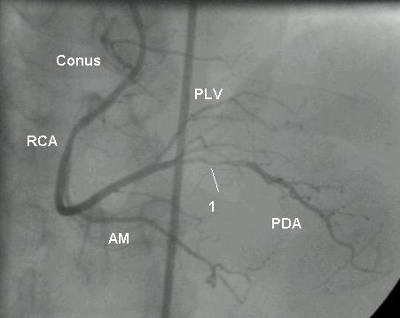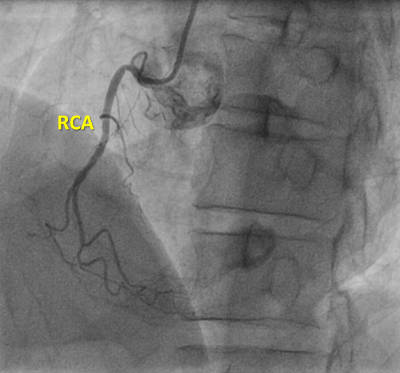Dominant right coronary artery – Medicine MCQ
Dominant right coronary artery means?
a) Right coronary artery supplies major portion of the myocardium
b) Right coronary artery crosses the crux and gives rise to posterior left ventricular branches
c) Right coronary artery supplies major portion of the left ventricle
d) None of the above
Correct answer: b) Right coronary artery crosses the crux and gives rise to posterior left ventricular branches
 Dominant right coronary artery – Angiogram
Dominant right coronary artery – Angiogram
[ RCA = right coronary artery, Conus = conus branch of the right coronary artery, AM = acute marginal branch, PLV = posterior left ventricular branch, 1 = obstructive lesion in proximal portion of posterior descending artery (PDA). ]
- Crux is the junction of the interventricular and atrioventricular grooves posteriorly.
- The dominant artery crosses the crux and supplies the opposite side.
- If right coronary artery is dominant, it crosses the crux and supplies posterior left ventricular branches.
- If left coronary artery is dominant, it crosses the crux and also gives rise to the left posterior descending artery (LPDA).
- In right dominant system, it is the right coronary artery which gives rise to the posterior descending coronary artery (PDA).
- Sometimes the arteries may be codominant.
- It may be noted that regardless of the anatomical dominance of the coronary arteries, it is always the left coronary artery which supplies the major portion of the left ventricular myocardium (and also the total myocardium as right ventricular myocardial mass is quite low compared to that of left ventricle).
- If the right coronary artery is non dominant, lesions in the non dominant artery are ignored from the point of view of coronary revascularization procedures like percutaneous coronary angioplasty.
 Non dominant right coronary artery (RCA) – Angiogram
Non dominant right coronary artery (RCA) – Angiogram
(In contrast to the first image, the RCA does not give rise to the posterior left ventricular branch)






Isn’t it the pda that decides dominance.Here it is given as plv.Please edit
@issac, In coronary anatomy, dominant artery is defined as the artery which crosses the crux to the opposite side. Usually that artery also gives rise to the posterior descending artery (PDA) in the posterior interventricular groove. Strictly speaking, PDA arises at the crux and not beyond that. Both left circumflex coronary artery (LCX) and right coronary artery (RCA) can sometimes give rise to PDA in a given case (co-dominant) – RPDA + LPDA, both located side by side in the posterior interventricular groove. If right coronary artery is dominant it gives rise to PDA and PLV branches. If left is dominant it gives rise to PDA and PLV branches.